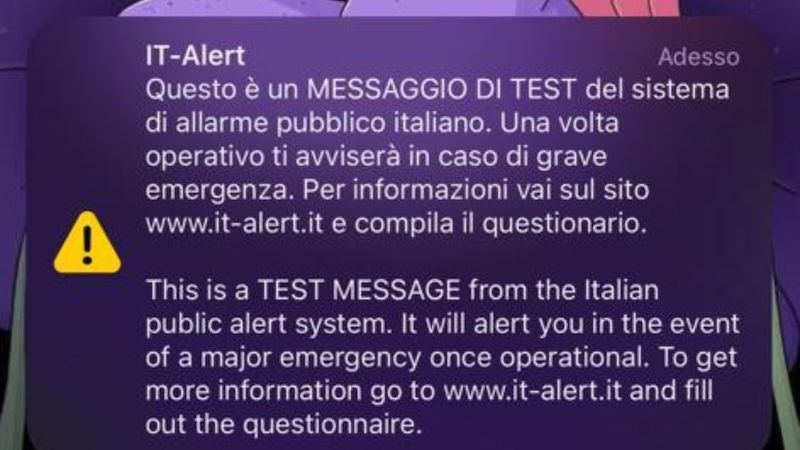Many of us, during the summer, will have experienced a small scare when hearing a loud and rather annoying sound coming from our smartphone.
It was the test of IT-alert, the national public alert system for Civil Protection information directed to the population.
After a stop of a few weeks, the IT-alert tests resume today, Tuesday 12 Septemberwhich will involve three regions: Campania, Friuli-Venezia Giulia and Marche.
Let’s first see what the new national public warning system is, and then find out what (and when) will happen today.

Cos’è IT-alert
What IT-alert is is explained well on a page on the official website, where it is also underlined that it is a service still in an experimental phase.
This is, as already mentioned, the “new public alarm system for direct information to the population, which sends useful messages to mobile phones in a specific geographical area in the event of serious emergencies or imminent or ongoing disasters.”
Still in testing phase, IT-alert when it is active it will allow the Civil Protection to inform the population, “with the aim of encouraging the adoption of self-protection measures in relation to the specific type of risk and the reference context.”
IT-alert will not replace but will complement existing alarm systems. Its main objective is to provide information on dangerous situations as quickly as possible.
How IT-alert works
If at the beginning of the article we talked about a strange and powerful sound, it is no coincidence. Already in the IT-alert tests the message was in fact broadcast through “a sound that is easily recognizable and different from classic ringtones.”
Once operational, the tool will send a message to anyone who is in an area affected by the emergency (and, of course, has an active mobile phone).
Through cell-broadcast technology, the message is sent to a group of telephone cells adjacent to each other and close to the interested area, even in the case of limited range or saturated telephone bandwidth.
The objective is to minimize individual and collective risks. For this reason, so that the message is immediately understandable by everyone, the language was simplified by a group of researchers, subordinating every other aspect to the accessibility of the text.
3,000 volunteers distributed throughout the national territory participated in the usability of the message.
IT-alert, privacy and conspiracy theories
Given the importance of the IT-alert message when it is in operation, upon its receipt all other functionality of the device is suspended.
There is no implication regarding privacy, both because neither registration nor access to particular sites are required, and because no data is retained. The Civil Protection explains it: “The system is one-way (from the telephone operator to the device) and does not allow receiving any type of return data or feedback from the cell phones reached. This means that no personal data of the person receiving the message is processed in any way by the Department of Civil Protection and by the relevant telephone operator.”
Yet, as we told you in another article, even in this case there was no shortage of conspiracy theorists on duty. Who have identified IT-alert as a new form of illegal population control.
The IT-alert test of September 12th
We were saying that today, Tuesday 12 September, the IT-alert tests will resume. Which will involve Campania, Friuli-Venezia Giulia and Marche. The message, and related sound warning, should reach the population around 12 noon.
We remember that the tests are used to verify the functioning of IT-alert on the various types of telephone and on the different operating systems.
The message also contains a request to complete a questionnaire, in order to implement the service.
The testing calendar
The first phase of IT-alert testing began on June 28th in Tuscany, continuing in Sicily, Sardinia, Calabria and concluding on July 10th with Emilia-Romagna.
After the three regions involved today, on 14 September it will be the turn of Piedmont, Puglia and Umbria, while on 19 September it will be the turn of Basilicata, Lombardy and Molise.
On 21 September the IT-alert test moves to Lazio, Valle d’Aosta and Veneto. And on the 26th in Abruzzo and in the Autonomous Province of Trento.
Finally Liguria on 27 September and the Autonomous Province of Bolzano on 13 October.
The alarm will always sound around 12.00. The calendar may be subject to change if the regional civil protection systems are involved in emergencies or alerts on the days chosen for the test.















Leave a Reply
View Comments